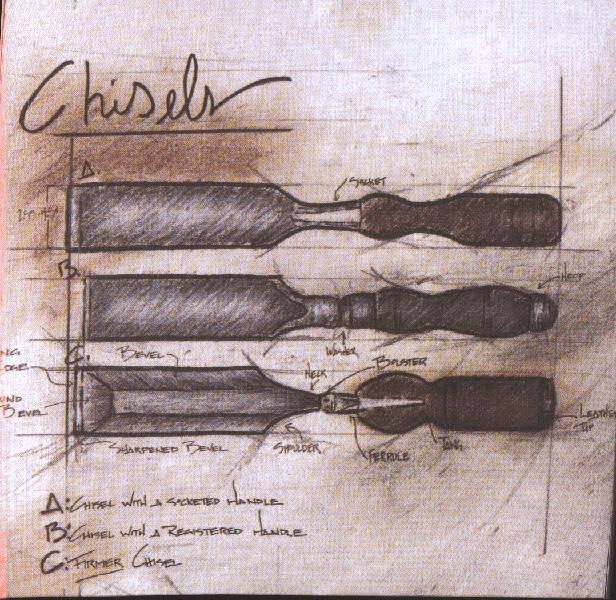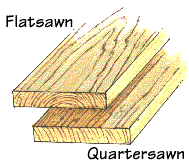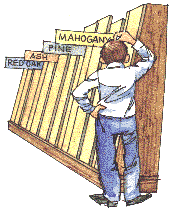SPLINTERS
Tennessee Valley Woodworkers
 Vol. 16/ Issue2
February 2001
Editor: Tom Gillard
Vol. 16/ Issue2
February 2001
Editor: Tom Gillard 

Meeting Notice:
The next meeting of the TN Valley Woodworkers
 Will be held,
February 20 at 7:00 p.m. in the
Will be held,
February 20 at 7:00 p.m. in the
Duck River Electric Building, Decherd, TN
All interested woodworkers are invited!


The following people have agreed to serve as contacts for their particular
skills. If you have questions, suggestions for activities, or other
comments relating to these skills, please call these folks. Their
interest is to help the club better serve their area of expertise.
Your participation with them will help them achieve that goal.
Alice Berry 454-3815 Design
Phil Bishop 967-4626
Finishing
Tom Church 967-4460 Turning
Harry May 962-0215
Carving
Bob Reese 728-7974 Sharpening
Jim Van Cleave 455-8150 Jointery
Maurice Ryan 962-1555 Health and Safety

CPSC, Black and Decker Inc. Announce
Recall
to Repair 12-inch Miter Saws
The Great American Hardwood Forest
Dateline: 07/11/99
The temperate forests of the United States contain more than fifty
important broad-leaved tree species. Most are commercially sought
- some have uses that are not considered commercial. This massive
hardwood forest is spread over 730 million acres (302 million
hectares) of United States forest and extends from North-East to
South across 2000 miles (3000 kilometers). Forty percent of the
timber growing there are hardwoods (deciduous), 60 percent are
evergreens (coniferous).
The major portion of The Great American Hardwood Forest occurs
in the eastern third of the United States and the country can be
divided into five regions. Each region has many different forest
types. These forest types maintain their own character based on
local climate, topographic, and soil conditions. Most hardwood
species overlap a bit and are growing in several regions.
The Southern Region touches the Atlantic and Gulf coast from
Maryland and Delaware to Texas, then north through the lowlands of
Oklahoma, Arkansas, and Missouri, and east via the Ohio River
Valley. This is the largest hardwood producing region. Abundant
stands of sweetgum, red and white oaks, hickories, yellow-poplar,
ash, hackberry and cottonwood are growing.
The Appalachian Region covers the mountain areas of New
York, New Jersey, Pennsylvania, Maryland, Virginia, West Virginia,
Ohio, Kentucky, Tennessee, North Carolina and northern parts of
Missouri, Alabama and Georgia. Major species in the region include
red and white oak, yellow-poplar, walnut, the maples, ash and
hickory.
The Northern Region encompasses the New England states, the
Great Lake states and the upper Mississippi valley. Species in this
area include the maples and oaks, cherry, ash, the birches, beech,
and basswood.
The Central Region includes some or all of 13 different states
located mostly in the central lowlands: Ohio, Indiana, Illinois,
south-western Wisconsin, Iowa, South Dakota, Nebraska, Kansas,
northern Oklahoma and Arkansas, Missouri and western Kentucky.
The principal species are walnut, the oaks, the hickories, ash, the
maples, yellow-poplar, basswood and cottonwood.
February's Program Preview:
The program for the February 20 meeting will be by John
Sargent, a long time member, and fine craftsman. John will present
a program describing development of his segmented turnings.
January 2001 Minutes
The January 2001 meeting of the Tennessee Valley Woodworkers was called
to order at 7:00 PM by President Tom Cowan. We had an attendance of 61.
Our guests were: Ray Johnson, Julie and Grant Woods, Bob Gunderson, Josh
Thompson (Doyle McConnells grandson), Dave Jones, Sheila Thompson and
son Zach. We also welcomed back our long lost member Winfield Bennett.
Announcements:
President Tom Cowan announced an Executive meeting to be held January
30th to discuss future workshops. Tom announced the Woodworking show February
2, 3, and 4 in Lavergne, Tn and suggested car pooling might be a good idea.
Refreshments were provided by Houston and Lily
Clark. Thank You!
A financial statement was given by our treasurer, Henry Davis. Jim VanCleve
made us aware of the importance of safety in the shop by sharing an accident.
Maurice Ryan had an article in the newspaper for the promotion of the club.
Show and tell:
John Sargent two segmented bowls
Tom Cowan two mahogany church collection plates
Loyd Ackerman butternut bowl and holly bowl
Ruth Ryan wooden Christmas ornaments
Maurice Ryan pictures of a restored antique vanity
Tim Halbeck turkey call and an oak ball made for a tugboat company
Bob Gunderson turned poplar porch railing spindle
Dean Lutz rustic Shaker style pegs and a sourwood candleholder
Manuel Brown metal scraper tool for lathe
Ross Roepke brought patterns for the replaceable table saw inserts
and showed an occasional mahogany table
Harold Hewgley photo album of an 1860 renovated home
Harry May elephant carved out of black gum
Tom Church brought magazines with an article for turning green wood
Jim Roy walnut top for a tip top table. Chopping block cabinet with
drop leaf made of curly maple and oak
Tom Gillard a circle cutting jig for router
Our program was presented by Bob Levine, a knife make for Tullahoma.
Mr. Levine is a member of the American and German Knife Makers Guilds.
He has been making knives since 1982. The knife handles are made from woods
with wild grains and exotic obscure woods. All knives have handmade hollow
ground blades. These knives have their own genuine leather sheaths made
by Mr. Levine.
Until next month!
Shirley Bishop
Be aware: Some
woods move more than others
Although you will never come across a wood species that does not
move, it pays to know what woods move the most or the least and
exactly how far they might move. To find out, we worked with
experts at the U.S. Forest Service's Forest Products Laboratory to
develop two charts. Click here to view Softwood
Chart (182k) or
Hardwood
Chart (217k). For printing the charts, click here for
Downloadable
Charts (34k) in Acrobat 3.0 format.
Most wood movement that will affect your work will occur across

the width of a workpiece. And, that amount will vary depending on
whether your boards are flatsawn or quartersawn. As shown in the
illustration below, you can tell these boards apart by looking at the
grain pattern on their ends and surfaces.
You don't need to be concerned about shrinkage or swelling along a
board's length or thickness. That's because wood moves a negligible
amount along its length, and boards less than 2" thick move little in
that dimension as well.
In the chart, we've listed the potential cross-grain movement for a
12"-wide workpiece. These figures apply to single workpieces or

multiple workpieces glued up for width. Of course, you can use
these figures to calculate the potential movement for pieces wider or
narrower than 12". Just divide the width of your workpiece by 12,
then multiply that number times the figure in the right column of the
chart. For example, say you make up a 26"-wide panel of black
ash. Dividing 26 by 12 equals 2.166. By multiplying 2.166 times
.250 (for flatsawn stock), you come up with the potential movement
of your 26"-wide panel: .542".
Now, what can you do to deal successfully with this movement?
Plenty, as you'll see from our list of strategies that starts here.
STRATEGY 1: Use the chart when
you're building a project that
requires relatively tight clearances between moving parts. When
practical, choose from among those woods that move less than
other varieties available to you.
STRATEGY 2: With the help of this
information, decide how
much allowance you must make for wood movement when planning
your projects. In the example
discussed earlier, the panel could
move more than 1/2" from season to season. So, you have to allow
the panel to shrink and swell about 5/8" across its width. (When
you're in doubt about how far a workpiece will move, always err on
the side of allowing more movement room than necessary.)
MORE NEXT MONTH....
Software of interest
Don Michelotti, the creator
of Sheet Layout for Windows has
updated this popular software program. He has a new site where you can
read about and download the latest version today! Sheet Layout is
a Windows based program that allows you to generate layouts for most
effecient use of sheet goods like plywood and laminates. (7/8/99)
Atlantis Software Development introduces their new EasyCab
v4.0 Cabinet Designer. This is the real thing! Familiar Windows format
with all the features a professional cabinet builder would expect from
a state-of-the-art cabinet design program! EasyCab has just been upgraded
to include both American and metric measurement capabilities and now comes with a project manager. You can now put up to 52 cabinets per
cutlist, sorted, labeled and print on Avery mini labels (2160). Keep
track of complex projects, produce master cutlist of All, just cabinets,
doors, drawers, face frames, and shop drawings of the whole project. Quick
viewing and editing of all cabinets in the project. This software has it
all! Download a trial version today to see why this is where you end your
search for design software! (5/9/99)

WEB
SITES of INTEREST
Arrowmont
School of Arts and Craft
WOOD
ONLINE newsletter
Falls Mill
Appalachain
Center for the Arts
Forest
Products Lab. 1999 Wood Handbook
Jim DelToro
Highland Hardware
Woodworker's
Journal
FOR SALE
1 HP / 1 Bag Woodtec dust collector -- $75 -- Loyd Ackerman
#20 Biscuits $2.75 per 50 Call and I'll bring to the meeting.
Tom Gillard (w) 393=0525

 Saw Blade Sharpening Services:
Branching Out is now offering their services as a drop off spot to have
your saw blades sharpened. The blades will be picked up (Tuesdays),
sharpened, and dropped back off at Branching Out. The Leitz Tooling
Systems out of Collierville, TN will do the sharpening. Call (393-0525)
or stop by for details.
Saw Blade Sharpening Services:
Branching Out is now offering their services as a drop off spot to have
your saw blades sharpened. The blades will be picked up (Tuesdays),
sharpened, and dropped back off at Branching Out. The Leitz Tooling
Systems out of Collierville, TN will do the sharpening. Call (393-0525)
or stop by for details.
Webmaster:
Tom Gillard Jr.

 Vol. 16/ Issue2
February 2001
Editor: Tom Gillard
Vol. 16/ Issue2
February 2001
Editor: Tom Gillard 
![]()
Will be held,
February 20 at 7:00 p.m. in the
![]()
![]()
![]()


